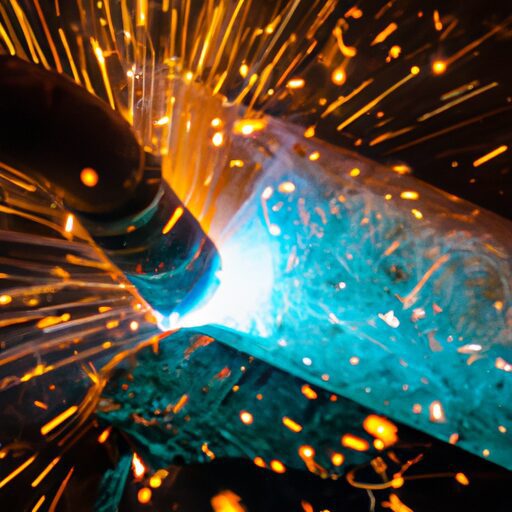In the fascinating world of welding, the possibilities are endless when it comes to joining materials together. From the classic combination of metal to metal, to the innovative fusion of plastic and metal, the art of welding has evolved into a versatile craft. Whether you’re building a skyscraper or creating intricate artwork, understanding the compatibility of different materials is key. In this article, we will explore the fascinating realm of welding and discover the endless possibilities that arise when different materials come together in perfect harmony. So hold on tight as we embark on an exciting journey through the world of welding!
Metals
Metals are widely used in various industries due to their strength, durability, and versatility. When it comes to welding different types of metals together, it’s essential to consider their compatibility for a successful bonding process.
Similar Metals
Welding similar metals is relatively straightforward, as they have comparable properties and chemical compositions. This compatibility ensures a strong and reliable bond between the metals. For example, welding two pieces of stainless steel or aluminum together can be achieved with ease, as they have similar melting points and exhibit excellent weldability.
Dissimilar Metals
Joining dissimilar metals through welding requires careful consideration to ensure a robust bond. Combining metals with different properties, such as copper and steel, can be challenging due to their distinct melting points and thermal conductivity. However, with the right welding techniques and suitable filler materials, dissimilar metals can be successfully welded together.
Plastics
Plastics, with their lightweight and versatile nature, have become a popular material in many industries. Welding plastics offers a reliable method of joining plastic components to create strong and durable structures.
Thermoplastics
Thermoplastics, such as polyethylene and polypropylene, can be easily welded together by applying heat to the joining surfaces. The heat softens the plastic, allowing it to fuse when pressed together. This welding technique is commonly used in industries like automotive and construction.
Thermosetting Plastics
Unlike thermoplastics, thermosetting plastics cannot be melted and re-molded, making welding a more complex process. However, specialized techniques such as ultrasonic welding or adhesive bonding can be used to join thermosetting plastics together. These methods utilize heat or chemical agents to create a strong bond between the materials.
Ceramics
Ceramics are known for their high-temperature tolerance and excellent electrical insulation properties. Welding ceramics, however, presents several challenges due to their brittle nature and unique composition.
Similar Ceramics
When welding similar ceramics, one common technique involves the use of a high-temperature process known as brazing. This method involves melting a filler metal with a lower melting point than the ceramic, which then flows and bonds the two materials together. Brazing can effectively join ceramics like alumina or zirconia.
Dissimilar Ceramics
Dissimilar ceramics pose a greater challenge in welding due to their varying thermal expansion coefficients and brittleness. Laser welding, with its precise heat control, can be employed to weld dissimilar ceramics. This technique minimizes thermal stress on the materials during the welding process, enabling a successful bond.
Glass
Glass is a fragile yet versatile material used in various applications, including windows, bottles, and optical devices. Although traditional welding is not feasible for glass, specialized bonding techniques can achieve reliable and aesthetically pleasing joints.
Similar Glass
Similar glass types, such as soda-lime or borosilicate glass, can be bonded using various methods. UV-cured adhesive or two-component epoxy bonding are commonly used techniques to create strong and transparent joints between glass pieces. These methods offer both structural integrity and visual clarity.
Dissimilar Glass
Bonding different types of glass requires more precise techniques due to the variations in physical and chemical properties. One effective method is anodic bonding, which involves heating and applying an electric field between the glass surfaces. This process creates a strong bond by fusing the ions within the glass layers.
Wood
Wood has been a staple material in construction and furniture industries for centuries. Joining wood together can be achieved through a variety of techniques, including traditional woodworking methods and more modern approaches like welding.
Wood to Wood
The most common method for joining wood to wood is through traditional woodworking techniques. These may include butt joints, dovetails, or mortise and tenon joints. These methods rely on mechanical fasteners, such as screws or nails, to create a secure bond between the wood pieces.
Wood to Metal
When it comes to joining wood to metal, welding techniques can offer a reliable and strong bond. Welding procedures such as brazing or arc welding can be used to create welds between wood and metal, providing a secure connection. However, caution must be exercised to ensure the wood does not catch fire during the welding process.
Composites
Composites refer to materials comprised of two or more different constituent materials, resulting in enhanced properties. Welding composites requires careful consideration of the compatibility of the materials involved to achieve desired results.
Fiber-Reinforced Composites
Fiber-reinforced composites, such as carbon fiber or fiberglass, combine the strength of fibers with a matrix material. Joining these composites can be challenging due to the different thermal expansion coefficients between the fibers and the matrix. Techniques such as resin bonding or adhesive bonding are commonly used to weld fiber-reinforced composites together.
Metal-Matrix Composites
Metal-matrix composites incorporate metal reinforcements, such as ceramic particles, within a metal matrix. These composites offer high strength and heat resistance. Welding metal-matrix composites typically involves specialized techniques like friction stir welding, which employs a rotating tool to join the materials without melting them.
Rubber
Rubber is a flexible material known for its elasticity and durability. Joining rubber materials to other substances may be necessary for various applications, including automotive components and seals.
Rubber to Metal
Welding rubber to metal can be challenging due to the different physical properties of the materials. One common method is using adhesive bonding, which involves applying a suitable adhesive or bonding agent between the rubber and metal surfaces. This creates a strong bond that can withstand the stresses and vibrations to which rubber is commonly exposed.
Rubber to Plastic
Joining rubber to plastic materials can be achieved through techniques such as overmolding or insert molding. Overmolding involves molding rubber directly onto a plastic part, creating a seamless and robust bond. Insert molding, on the other hand, involves placing a pre-formed rubber insert into a plastic mold, resulting in a combined part with excellent adhesion.
Fabrics
Fabrics play a vital role in the fashion, upholstery, and textile industries. Joining fabrics together can range from simple techniques to more advanced methods.
Fabric to Fabric
Joining fabric to fabric can be easily accomplished through sewing or using techniques such as adhesive bonding. Sewing is a traditional and versatile method that provides a flexible and reliable bond. Adhesive bonding involves using fabric-specific adhesives to create a strong and seamless connection between fabric layers.
Fabric to Plastic
When bonding fabric to plastic, heat-sealing or ultrasonic bonding techniques can be employed. Heat-sealing involves using heat and pressure to melt the plastic and fuse it with the fabric, creating a secure bond. Ultrasonic bonding utilizes high-frequency vibrations to generate heat, effectively bonding the fabric and plastic together.
Leather
Leather is a durable and versatile material commonly used in various industries, including fashion, automotive, and upholstery. Joining leather to other materials requires specific techniques to ensure a strong and aesthetically pleasing bond.
Leather to Metal
For joining leather to metal, techniques such as adhesive bonding or riveting can be utilized. Adhesive bonding involves using suitable adhesives to create a strong bond between the leather and metal surfaces. Riveting, on the other hand, utilizes metal fasteners or rivets to secure the leather onto the metal, creating a reliable connection.
Leather to Plastic
When joining leather to plastic, adhesive bonding is commonly used to create a robust bond between the materials. High-quality adhesives specifically designed for bonding leather and plastic surfaces together ensure a secure connection that can withstand various stresses and strains.
Paper
Paper is a lightweight and flexible material widely used in packaging, printing, and stationery. Joining paper materials together may be necessary for creating complex structures or repairing damaged items.
Paper to Paper
Joining paper to paper can be achieved through techniques such as adhesive bonding or using staples or other mechanical fasteners. Adhesive bonding utilizes paper-specific adhesives to create a strong and seamless bond between paper surfaces. Mechanical fasteners like staples or clips offer a quick and reliable method for securing multiple paper sheets together.
Paper to Plastic
To join paper to plastic materials, heat-sealing is a commonly employed technique. Heat-sealing involves applying heat and pressure to melt the plastic and fuse it with the paper, creating a secure and permanent bond. This method is frequently used in packaging to create airtight seals and protect the contents inside.





































